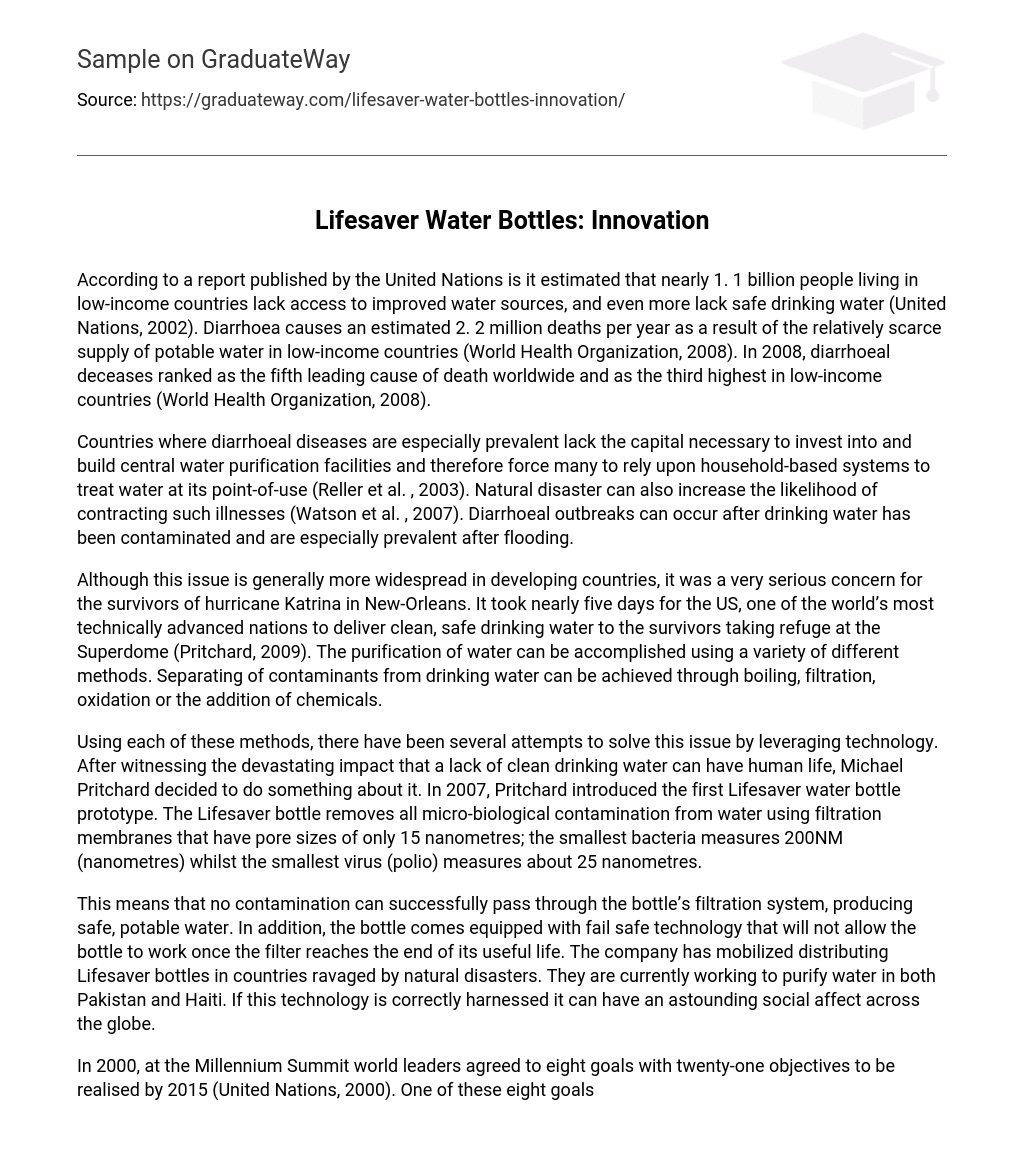According to a report published by the United Nations is it estimated that nearly 1. 1 billion people living in low-income countries lack access to improved water sources, and even more lack safe drinking water (United Nations, 2002). Diarrhoea causes an estimated 2. 2 million deaths per year as a result of the relatively scarce supply of potable water in low-income countries (World Health Organization, 2008). In 2008, diarrhoeal deceases ranked as the fifth leading cause of death worldwide and as the third highest in low-income countries (World Health Organization, 2008).
Countries where diarrhoeal diseases are especially prevalent lack the capital necessary to invest into and build central water purification facilities and therefore force many to rely upon household-based systems to treat water at its point-of-use (Reller et al. , 2003). Natural disaster can also increase the likelihood of contracting such illnesses (Watson et al. , 2007). Diarrhoeal outbreaks can occur after drinking water has been contaminated and are especially prevalent after flooding.
Although this issue is generally more widespread in developing countries, it was a very serious concern for the survivors of hurricane Katrina in New-Orleans. It took nearly five days for the US, one of the world’s most technically advanced nations to deliver clean, safe drinking water to the survivors taking refuge at the Superdome (Pritchard, 2009). The purification of water can be accomplished using a variety of different methods. Separating of contaminants from drinking water can be achieved through boiling, filtration, oxidation or the addition of chemicals.
Using each of these methods, there have been several attempts to solve this issue by leveraging technology. After witnessing the devastating impact that a lack of clean drinking water can have human life, Michael Pritchard decided to do something about it. In 2007, Pritchard introduced the first Lifesaver water bottle prototype. The Lifesaver bottle removes all micro-biological contamination from water using filtration membranes that have pore sizes of only 15 nanometres; the smallest bacteria measures 200NM (nanometres) whilst the smallest virus (polio) measures about 25 nanometres.
This means that no contamination can successfully pass through the bottle’s filtration system, producing safe, potable water. In addition, the bottle comes equipped with fail safe technology that will not allow the bottle to work once the filter reaches the end of its useful life. The company has mobilized distributing Lifesaver bottles in countries ravaged by natural disasters. They are currently working to purify water in both Pakistan and Haiti. If this technology is correctly harnessed it can have an astounding social affect across the globe.
In 2000, at the Millennium Summit world leaders agreed to eight goals with twenty-one objectives to be realised by 2015 (United Nations, 2000). One of these eight goals was to reduce the instance of child mortality. Pritchard contends that that by utilising the Lifesaver bottle, the UN can effectively provide drinking water for everyone on earth. Realizing Pritchard’s astonishing vision would create a monumental impact worldwide, “For $20 billion everyone can have access to safe drinking water. So the 3. 5 billion people that suffer every year… nd the 2 million kids that die every year will live” (Pritchard, 2009).
Works Cited
Pritchard, M. (August 2009). “Michael Pritchard’s water filter turns filthy water drinkable”. TED. http://www. ted. com/talks/lang/eng/michael_pritchard_invents_a_water_filter. html Pritchard, M. (n. d. ). Lifesaver systems. Retrieved from http://www. lifesaversystems. com/ Reller M, Mendoza C, Lopez M, Alvarez M, Hoekstra R, Olson C, Baier K, Keswick B, Luby S,. (2003). A randomized controlled trial of household-based flocculant-disinfectant drinking water reatment for diarrhea prevention in rural Guatemala. The American Society of Tropical Medicine and Hygiene, 69 (4). United Nations Development Program, Human Development Report 2002, 2002. New York: Oxford University Press. United Nation. (2000). Millennium development goals. Retrieved from http://www. un. org/millenniumgoals/poverty. shtml Watson, J, Gayer, M, & Connolly, M. (2007). Epidemics after natural disasters. Emerging Infectious Diseases, 13(1). World Health Organization. (2008). Top 10 causes of death. Retrieved from http://www. who. int/mediacentre/factsheets/fs310/en/index. html





